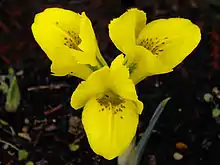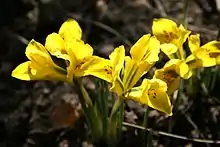Iris danfordiae
Iris danfordiae, the dwarf iris or Danford iris, is a bulbous perennial plant in the genus Iris, it is classified in the subgenus Hermodactyloides and section Reticulatae. It is from Turkey in Asia. It has 2 gray-green or bluish green, thick leaves, short slender stem holding a scented flower, in shades of yellow. They are spotted olive-green or green and have a deep yellow or orange crest.
| Iris danfordiae | |
|---|---|
 | |
| Scientific classification | |
| Kingdom: | Plantae |
| Clade: | Tracheophytes |
| Clade: | Angiosperms |
| Clade: | Monocots |
| Order: | Asparagales |
| Family: | Iridaceae |
| Genus: | Iris |
| Subgenus: | Iris subg. Hermodactyloides |
| Section: | Iris sect. Reticulatae |
| Species: | I. danfordiae |
| Binomial name | |
| Iris danfordiae | |
| Synonyms[1][2] | |
| |
Description
Iris danfordiae has a narrowly ovoid,[3] bulb,[4] with whitish netted coats.[5]
It has 2 leaves (per bulb),[5][6] 30–45 cm (12–18 in) tall.[7] They are linear,[8] four-angled in cross section,[6][9] and gray-green,[8] or bluish green.[5] The leaves sometimes appear together with the flowers,[8] and sometimes after the flowers.[6]
It has a slender stem, that can grow up to between 7–15 cm (3–6 in) tall.[6][7][8] They hold 1 flower each.[5][8]
It is one of the first reticulata irises to bloom,[10][11] even blooming through the snow.[12] In early spring,[4][7] between January,[7] and March.[9]
It has fragrant (scented of honey,[10]) flowers,[13] in shades of yellow.[14] From bright yellow,[10][15][16] deep yellow,[8] to orange.[9] The flowers are 3–6 cm (1–2 in) in diameter.[8]
Like other irises, it has 2 pairs of petals, 3 large sepals (outer petals), known as the 'falls' and 3 inner, smaller petals (or tepals), known as the 'standards'.[17]:17 The falls are spathulate (spoon shaped),[8] and spotted olive-green,[8][9] or green.[6][11][16] In the centre of the falls is a deep yellow or orange crest.[14][10] The standards are vert short,[8][14] in some cases just bristles.[6][16]
Later after flowering, it produces a seed capsule.[8]
Taxonomy

It is pronounced as (Iris) EYE-ris (aphylla) dan-FORD-ee-ay (danfordiae).[15] It is commonly known as dwarf iris,[18] buttercup Iris,[15] or Danford's iris.[15][9][19]
This species was introduced from Cilicia,[20] Turkey in 1876, by Mrs C. G. Danford (an English plant hunter of the Asia minor regions).[16][21]
It was first published and described as Xiphion danfordiae Baker and described by John Gilbert Baker in J. Bot. Vol.14 n page 265 in 1876.[3] It was then reclassified and published as Iris danfordiae by Pierre Edmond Boissier in 'Fl. Orient.' Vol.5 on page 124 in July 1882.[1][20]
Iris danfordiae is an accepted name by the RHS,[22] and it was verified by United States Department of Agriculture and the Agricultural Research Service on 23 January 1989, then updated on 2 December 2004.[2]
Distribution and habitat
It is native to temperate Asia,[2] mainly Asia Minor.[9]
Range
It grows in the Taurus Mountains of southern Turkey.[10][6][14]
Cultivation

It is cold hardy,[14] to between USDA Zones 5 - 9.[18][9][15] It is sometimes deemed less reliably perennial than other bulbs.[11]
It prefers to grow in neutral to alkaline soils, which are high in potassium and phosphate. It prefers sandy and well drained soils both in summer and winter.[12] It prefers positions in full sun.[8][15]
It is suitable for a rock or gravel garden or front of border.[23]
During mild season the bulb and plant is susceptible to slug damage.[6]
Propagation
It can be propagated by division or by seed growing. Seeds are best grown by collecting dry, mature seed capsules, and sowing the seeds.[15]
Division, is carried out by lifting the main bulb and splitting into many bulblets,[6] that (once replanted) can take many years to reach flowering size.[6][24] This is best carried out when the foliage has died down.[25]
The bulbs should be planted deeply to flower reliably in later seasons.[10]
Hybrids and cultivars
Iris danfordiae has the following cultivars: 'Atilla', 'Bornmülleri', 'Danfordiae Hort'.[3]
Toxicity
Like many other irises, most parts of the plant are poisonous (rhizome and leaves), if mistakenly ingested can cause stomach pains and vomiting. Also handling the plant may cause a skin irritation or an allergic reaction.[15][26]
References
- "Iris danfordiae (Baker) Boiss. is an accepted name". theplantlist.org. 23 March 2012. Retrieved 16 February 2018.
- "Iris danfordiae". Germplasm Resources Information Network (GRIN). Agricultural Research Service (ARS), United States Department of Agriculture (USDA). Retrieved 16 February 2018.
- Pries, R. (2 April 2010). "(SPEC) Iris danfordiae (Baker) Boissier". wiki.irises.org (American Iris Society). Retrieved 16 February 2018.
- Kelly D. Norris A Guide to Bearded Irises: Cultivating the Rainbow for Beginners and Enthusiasts, p. 17, at Google Books
- Dykes, William Rickatson (1913). The Genus Iris.
- "Iris danfordiae". encyclopaedia.alpinegardensociety.net. Retrieved 16 February 2018.
- Stebbings, Geoff (1997). The Gardener's Guide to Growing Irises. Newton Abbot: David and Charles. p. 66. ISBN 0715305395.
- Hoskovec, Ladislav (9 February 2014). "IRIS DANFORDIAE (Baker) Boiss. - Danford's iris" (in Czech). botany.cz. Retrieved 16 February 2018.
- Donald Wyman Wyman's Gardening Encyclopedia, p. 575, at Google Books
- "Reticulata Irises". pacificbulbsociety.org. Retrieved 16 February 2018.
- Christine Skelmersdale Gardener's Guide to Bulbs, p. 145, at Google Books
- Diana Beresford-Kroeger Iris danfordiae, p. 84, at Google Books
- Martyn Cox RHS How to Grow Plants in Pots, p. 42, at Google Books
- Plotner, Will (12 February 2004). "Iris danfordiae". signa.org. Retrieved 16 February 2018.
- "Species Iris, Dwarf, Reticulated Iris, Buttercup Iris, Danford Iris". davesgarden.com. Retrieved 16 February 2018.
- Dykes, William (2009). "Handbook of Garden Irises" (PDF). beardlessiris.org (The Group for Beardless Irises). Retrieved 1 November 2014.
- Austin, Claire (2005). Irises; A Garden Encyclopedia. Timber Press. ISBN 0-88192-730-9.
- "Dwarf Iris". theplantexpert.com. 12 October 2008. Retrieved 19 June 2014.
- John Greenlee The American Meadow Garden: Creating a Natural Alternative to the Traditional Lawn, p. 116, at Google Books
- "Iridaceae Iris danfordiae Boiss". ipni.org (International Plant Names Index). Retrieved 16 February 2018.
- MATHEW, BRIAN (1 May 2007). "Irises: An expert reveals the secrets of growing the jewel-like reticulatas". hortmag.com. Retrieved 18 June 2014.
- "Iris danfordiae". www.rhs.org.uk. Retrieved 31 October 2014.
- Leah Chester-Davis The Successful Gardener, p. 83, at Google Books
- "Iris". bbc.co.uk. 2014. Retrieved 19 June 2014.
- David Squire The Propagation Specialist: The Essential Guide to Raising New Plants for the home and garden, p. 66, at Google Books
- David G Spoerke and Susan C. SmolinskeToxicity of Houseplants, p. 236, at Google Books
Other sources
- Aldén, B., S. Ryman, & M. Hjertson Svensk Kulturväxtdatabas, SKUD (Swedish Cultivated and Utility Plants Database; online resource on www.skud.info). 2012 (Kulturvaxtdatabas)
- Davis, P. H., ed. Flora of Turkey and the east Aegean islands. 1965-1988 (F Turk)
- Mathew, B. The Iris. 1981 (Iris) 173-174.
External links
![]() Media related to Iris danfordiae at Wikimedia Commons
Media related to Iris danfordiae at Wikimedia Commons
![]() Data related to Iris danfordiae at Wikispecies
Data related to Iris danfordiae at Wikispecies